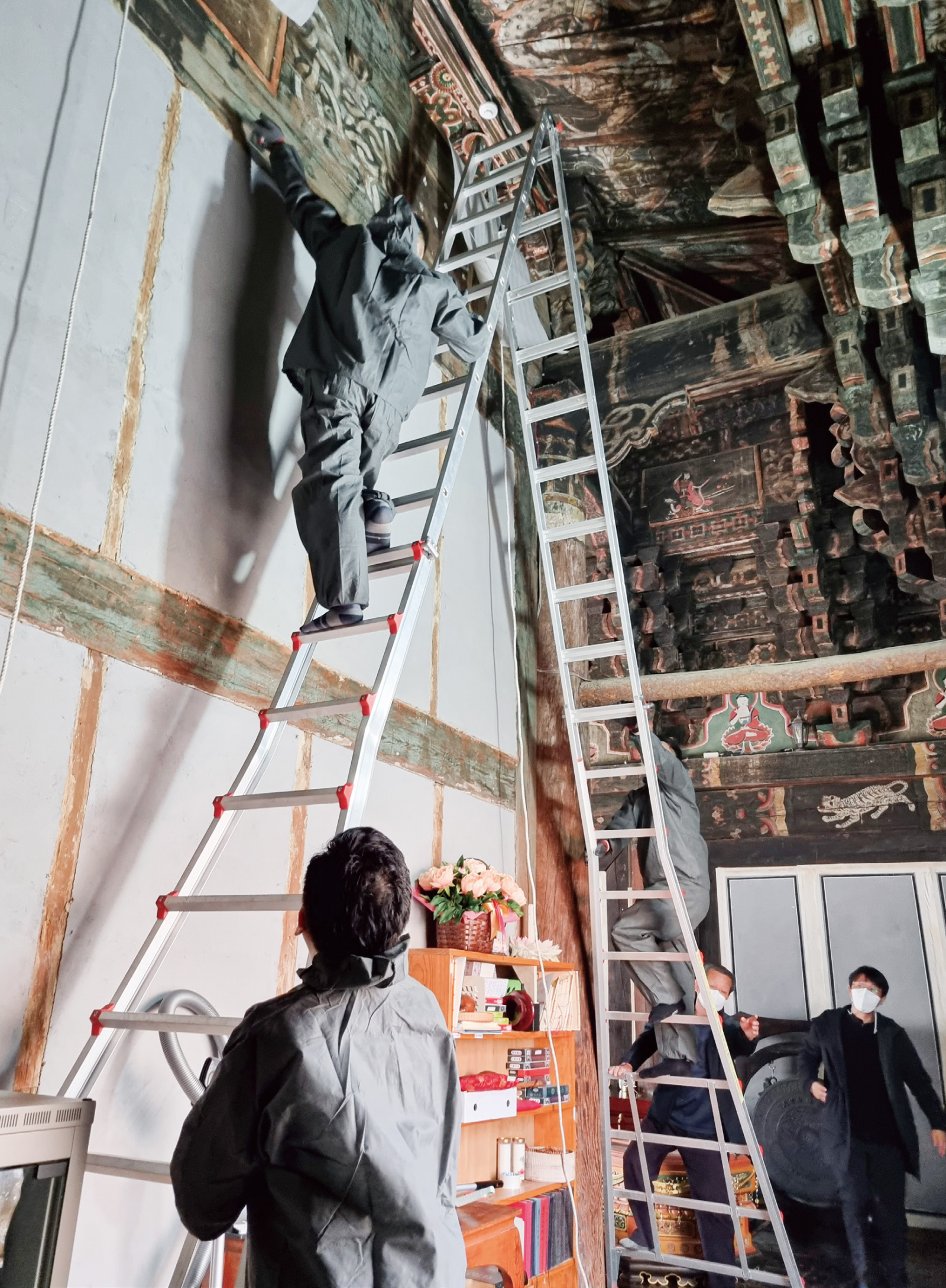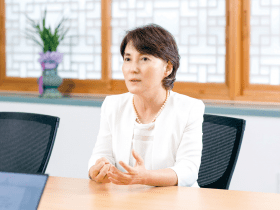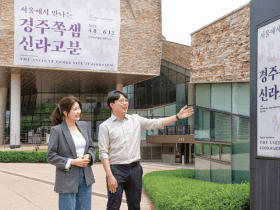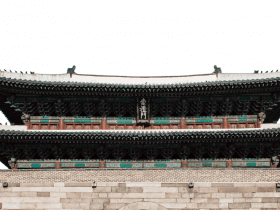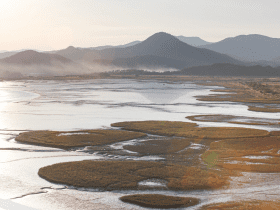Buryeongsa Temple Heritage Urgently Evacuated During Uljin Wildfire
Gyeongju National Research Institute of Cultural Heritage
Sim, Myungbo


March 4, 2022, Buryeongsa Temple Placed in Danger of Fire Due to Uljin Wildfire
On March 4, a wildfire broke out in Uljin, Korea’s eastern costal county. Driven by strong winds and dry weather, the fire spread rapidly. If the fire continued to blaze, cultural heritage in the Uljin area were expected to suffer from fire damage. The Cultural Heritage Risk Management Division of the Cultural Heritage Administration (CHA) kept an eye on the Uljin wildfire as the wildfire continued the next day, heading south and drawing closer to the Buryeongsa Temple, founded by the great monk Uisang during Silla era. The fire approached as close as about 7 kilometers, and Buryeongsa Temple, one of the representative heritage of Uljin, was in danger of being burned down.
Buryeongsa Temple was founded in 651 (the fifth year of the reign of Queen Jindeok of Silla Kingdom) and is currently a branch temple of Bulguksa Temple in Gyeongju, the head temple of the 11th district of the Jogye Order of Korean Buddhism. Buryeongsa Temple’s Eungjinjeon Hall and Daeungbojeon Hall as well as the Buddhist Painting (The Vulture Peak Assembly) and Buddhist Palanquins are designated as Treasure. The temple’s Three-Story Stone Pagoda, Buddhist Tablet and Buddhist Painting (Guardian Deities) are City/Province-Designated Tangible Cultural Heritage and the Stupa is Cultural Heritage Material. If the Buryeongsa Temple gets burnt down in a fire, valuable assets including designated cultural heritage and scenic sites will lose their value. Such crisis was just upon Buryeongsa Temple in March.
Gyeongju National Research Institute of Cultural Heritage on Mission to Evacuate Cultural Heritage of Buryeongsa Temple
At 1 p.m. on March 6, Sunday, Researcher Sim Myungbo of the Gyeongju National Research Institute of Cultural Heritage received an urgent phone call. He had just returned to Gyeongju from a trip to Seoul with his family. He heard from the Cultural Heritage Administration that the heritage objects in the Buryeongsa Temple should be evacuated urgently. Senior researcher Kang Dongseok and researchers Kim Dongha, Park Jeongjae and Sim Myungbo, who were in Gyeongju at the moment, headed to the temple immediately with the necessary equipment. In constant communication on their way, they were receiving information on what has to be evacuated, how many items need to be evacuated and what was needed for evacuation. Driving for three hours without a break, they arrived at the Temple where the sky was already red and the air was smoky. Firefighting helicopters were continuously carrying water from the river to spray water over the flames.
The researchers from the Gyeongju National Research Institute of Cultural Heritage were assigned to take charge of the wrapping and transferring the four pieces of three designated heritages, including the two Buddhist Palanquins, the Buddhist Painting of The Vulture Peak Assembly and the Buddhist painting of Guardian Deities. These cultural heritages required a more professional handling in packing and moving compared to other heritages of the temple.
Buddhist Palanquin, the Most Difficult to Pack Due to Many Ornaments and Sculptures
As soon as they arrived at Buryeongsa Temple, the researchers checked on the relics to be moved and confirmed the sequence of work. The first to be packed were the Buddhist Palanquins. The Buddhist palanquin is an important element of Buddhist rituals, carrying the object of worship such as Buddhist tablets, Buddhist bone relics or Buddhist scriptures. The two Buddhist palanquins in Buryeongsa Temple could be separated into smaller parts of the handle, seat and the roof. The handle part consists of two long shafts with dragons carved on the edge and at the end of the shaft. The four sides of the seat are splendidly colored and sculptured, and glass bead windows are fitted on three sides. The corners of the roof are decorated with carvings believed to be phoenixes with a lotus flower sculpted in the center. Sophisticatedly produced, the palanquin is known to be the oldest one of such kind in the Joseon Dynasty and recognized for its cultural values.
The Buddhist palanquins were created with various materials and in a three-dimensional structure, so the researchers had to approach carefully to pack the palanquins despite the urgency. Even the slightest wrong move would harm the decorations or cause the glass beads to fall off. However, evacuation could not be delayed. The researchers immediately reviewed ways of packing and decided to separate the roof and the seat of the palanquin to minimize the damage caused by the movement. Sharp, protruding parts were wrapped with acid-free paper and soft packing material to prepare for possible impact and damage and joint structures were tied together with strings to prevent them from falling off. The Buddhist palanquin was tied to a wooden base to minimize vibration. This was the moment when the researchers of the Gyeongju National Research Institute of Cultural Heritage showed their expertise on cultural heritage conservation.






Difficulty in Disassembling Large-Scale Buddhist Paintings
As soon as the complex structure and decorations of the Buddhist palanquins were packed, the researchers set on dismantling and wrapping the Buddhist Painting of Buryeongsa Temple (The Vulture Peak Assembly), which is over 4 meters long. The painting, located behind the Buddhist statues, describes a scene in which Buddha is delivering a sermon. Typically, eight leading bodhisattvas are featured in the Vulture Peak Assembly paintings, but the one in Buryeongsa Temple has the Buddha surrounded by ten noticeably large bodhisattvas, five on each side of Buddha. It has been designated as a Treasure for its dignified style, unique composition and preservation in good conditions along with the markings at the bottom clearly stating the year and background of production. These aforementioned information made the painting a valuable material for studying the Buddhist paintings of the 18th century Joseon era.
The Buddhist Painting of the Vulture Peak Assembly was connected to the girder above the high ceiling. The height was barely reachable even with a ladder and working in an emergency could cause the person to fall and be easily injured. Luckily, there were firefighters on standby at the temple to prepare for the approaching wildfire and the researchers could remove the painting from the wall with the help from them. The researchers thought about how to pack it safely while minimizing damage after separating it from the wall. Normally, the painting is inspected for possible existing damage and packed after the saftey measures, but it was an urgent situation in the dark of night, so the researchers had no choice but to start packing right away after checking on the most problematic parts based on their experiences. First, they checked whether the colored pigment layer of the painting was strong enough and then covered the surface with acid-free paper. Then several people joined to roll the painting at the same speed to prevent it from being lopsided, and they successfully wrapped the painting safely.


The Buddhist Painting of Buryeongsa Temple (Guardian Deities), designated as City/Province-Designated Tangible Cultural Heritage, depicts protective deities who guard the Buddha Dharma and is enshrined in the Daeungbojeon Hall of the Temple. According to the text at the bottom, the painting was created in 1860 by five painters including ‘Uiundang Jau.’ Jau was a geumeo (painter monk specializing in dancheong paintwork or Buddhist painting) active in Gyeongsang and Gangwon Provinces and considered the most skillful painter of his time. The Buryeongsa Temple’s Guardian Deities painting is recognized for its precise description, harmonious use of color and decoration as a 19th century Buddhist painting and has been designated as a Tangible Cultural Heritage.
The Guardian Deities painting, which was in a square frame, was already taken down from the wall when the researchers arrived. Before wrapping it, the researchers protected the painting’s surface and its each corner to prevent from the possible damages. In order to protect the large-scale cultural heritages of the Buryeongsa Temple from possible damages during transportation, an air suspension vehicle was needed to reduce vibration. After asking all around, a truck equipped with air suspension was located near Uljin and was called to the temple in a hurry. The packed relics were safely positioned and fastened to prevent shaking as they were loaded onto the air suspension truck.
In an urgent situation of wildfire with entire nation’s attention, the researchers of the Gyeongju National Research Institute of Cultural Heritage were dispatched to the temple, packed and moved the artifacts without wasting an inch of time based on their best judgment at the critical moment.
From their arrival at the Buryeongsa Temple, it took exactly three hours to pack and load all the cultural heritages on the air suspension truck. The air suspension truck departed the temple over 9 p.m. They couldn’t see anything on the winding mountain road leading from the Buryeongsa Temple. Having a hard time passing through the mountain road with steep slopes and downhills, the truck finally entered a driveway. They then drove for four more hours at 60 kilometers per hour with convoys in front and behind. The four precious artifacts from the Buryeongsa Temple finally made their way to the storage of the Gyeongju National Research Institute of Cultural Heritage around early morning.


Evacuation of Heritage From Buryeongsa Temple Left Many Tasks
Fortunately, the Uljin wildfire did not spread further from 7 kilometers away from the Buryeongsa Temple. The four relics, stored at the Gyeongju National Research Institute of Cultural Heritage, were safely returned to the temple on March 24. The evacuation of the artifacts of the Buryeongsa Temple due to the Uljin wildfire demonstrated how well cultural heritage researchers promptly ran the emergency response network and how relevant departments and personnels closely cooperated with each other. However, it also awakened many concerns and challenges for the protection of the cultural heritages. Although museum storage or research centers are well designed and built considering the flow of traffic, the fire reminded that there are much more variables existing for the relics stored in deep mountains. There is still a lot of work to be done in reviewing and reorganizing in terms of cultural heritage protection such as preparing a space for quick evacuation in case of an emergency as well as securing an evacuation route and conducting emergency drills preparing for disasters.
Korea has already had the experience of losing the renowned cultural heritage Sungnyemun, the National Treasure, back in 2008. Due to the arson attack, all the wooden structures except for stonework were destroyed and its restoration process took over five years. Even after the restoration, there are controversies over whether the restored relic has the same cultural value as before the disaster. Fire damage takes a lot of time to restore and furthermore, it undermines the value of the heritage. This is the reason why we should pay close attention to fire protection cultural heritages and make an effort in establishing a risk management system.

